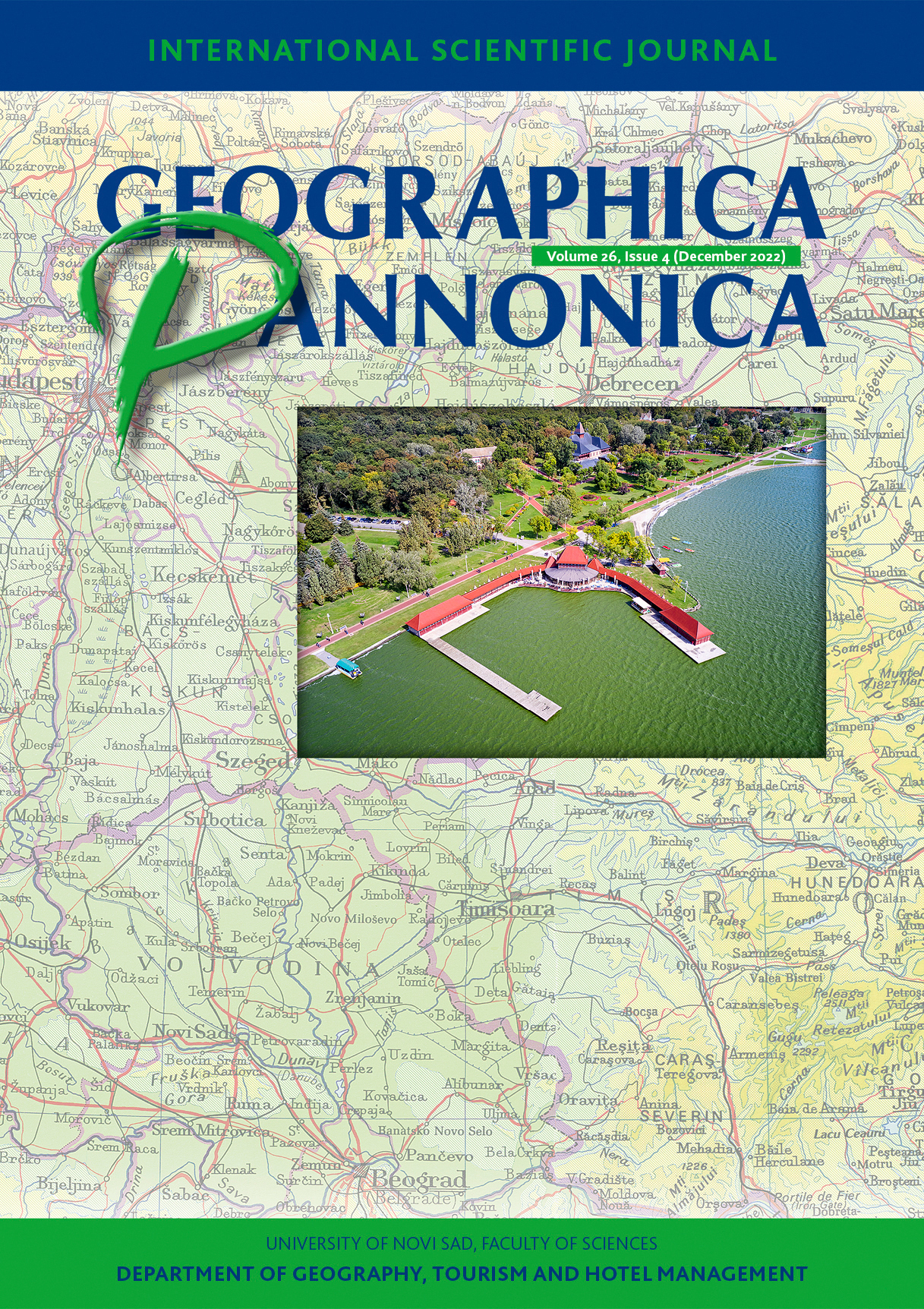Light Pollution Mapping in Pécs City with the Help of SQM-L and VIIRS DNB. The Effect of Public Luminaire Replacements on the Sky Background of the Urban Sky
Abstract
Recently light pollution has been one of the most dynamically increasing form of environmental pollution. Light, if it arrives at the wrong place, time, quantity and quality, is harmful to human health and the physical environment – not to mention that it is a mere waste of energy. The brightness of the sky above Pécs was measured by SQM-L instruments in 2011 and 2019. Maps of the different neighbourhoods with different levels of light pollution have been prepared. In addition, special VIIRS day/night band satellite images were also analysed using QGIS software. Our investigations coincided with the modernization of street lighting in the city. The impact of LED illuminators installed along main roads in Pécs was observed locally.
References
Árgay Z. (Ed) (2020). A fényszennyezésről – világosan! [Clear words about light pollution]. Budapest: Agrárminisztérium and Hortobágyi Nemzeti Park Igazgatóság.
Bará, S., Marco, E., Ribas, S. J., Gil, M. G., Sánchez de Miguel A., & Zamorano, J. (2021). Direct assessment of the sensitivity drift of SQM sensors installed outdoors. International Journal of Sustainable Lighting 23(1) 1–6.
Baugh, B., Hsu, F. C., Elvidge, C., & Zhizhin, M. (2013). Nighttime Lights Compositing Using the VIIRS Day-Night Band: Preliminary Results. Proceedings of the Asia-Pacific Advanced Network 2013 35, 70–86. http://dx.doi.org/10.7125/APAN.35.8>
Chen, H., Sun, C., Xiong, X., Sarid, G., & Sun, J. (2021). SNPP VIIRS Day Night Band: Ten Years of On-Orbit Calibration and Performance. Remote Sensing 13, 4179. https://doi.org/10.3390/rs13204179>
Duriscoe, D. M., Anderson, S. J., Luginbuhl, C. B., & Baugh, K. E. (2018). A simplified model of all-sky artificial sky glow derived from VIIRS Day/Night band data. Journal of Quantitative Spectroscopy & Radiative Transfer 214, 133–145. https://doi.org/10.1016/j.jqsrt.2018.04.028>
Elvidge, C. D., Baugh, K., Zhizhin, M., Hsu, F. C., & Ghosh, T. (2017). VIIRS night-time lights. International Journal of Remote Sensing 38, 5860–5879. http://dx.doi.org/10.1080/01431161.2017.1342050>
Faid, M. S., Shariff, N. N. M., Hamidi, Z. S., Sabri, S. N. U., Zainol, N. H., Husien, N. H., & Ali, M. O. (2016). Monitoring the Level of Light Pollution and Its Impact on Astronomical Bodies Naked-Eye Visibility Range in Selected Areas in Malaysia Using Sky Quality Meter. Journal of Industrial Engineering and Management Science 2016(1), 1–18. https://doi.org/10.13052/jiems2446-1822.2016.007>
Mezősi, G. (2022). Natural Hazards and the Mitigation of their Impact. Springer Cham.
Katz, Y. and Levin N. (2016). Quantifying urban light pollution — A comparison between field measurements and EROS-B imagery. Remote Sensing of Environment, 177, 65–77. http://dx.doi.org/10.1016/j.rse.2016.02.017>
Kolláth, Z., Dömény, A., Kolláth, K., & Nagy, B. (2016). Qualifying lighting remodelling in a Hungarian city based on light pollution effects. Journal of Quantitative Spectroscopy and Radiative Transfer 181, 46–51. https://doi.org/10.1016/j.jqsrt.2016.02.025>
Longcore, T., & Rich, C. (2004). Ecological Light Pollution. Frontiers in Ecology and the Environment 2(4), 191–198. DOI: 10.1890/1540-9295(2004)002[0191:ELP]2.0.CO;2
Nisar, H, Sarwar, F, Shirazi, S. A, Amjad, D., & Aslam, R. W. (2022). Assessment and Monitoring of VIIRS-DNB and SQML-L light Pollution in Lahore-Pakistan. International Journal of Innovations in Science and Technology 3(4), 94–109.
Pavlić, K., & Željko, A. (2020). Comparison of night sky brightness above Zagreb and a nearby rural location 2014-2017. Rudarsko-geološko-Naftni Zbornik 35(2), 45–56. https://doi.org/10.17794/rgn.2020.2.5>
Pun, C. S. J., So, C. W., Leung, W. Y., & Wong, C. F. (2014). Contributions of artificial lighting sources on light pollution in Hong Kong measured through a night sky brightness monitoring network. Journal of Quantitative Spectroscopy and Radiative Transfer 139, 90–108. https://doi.org/10.1016/j.jqsrt.2013.12.014>
Puschnig, J., Näslund, M. Schwope, A., & Wallner S. (2021). Correcting sky-quality-meter measurements for ageing effects using twilight as calibrator. Monthly Notices of the Royal Astronomical Society 502(1), 1095–1103, https://doi.org/10.1093/mnras/staa4019>
Puschnig, J., Wallner, S., Schwope A., & Näslund, M. (2022). Long-term trends of light pollution assessed from SQM measurements and an empirical atmospheric model. Monthly Notices of the Royal Astronomical Society, stac3003, https://doi.org/10.1093/mnras/stac3003>
Sanchez de Miguel, A., Kyba, C.C.M., Zamorano, J., Gallego, J., & Gaston, K. J. (2020). The nature of the diffuse light near cities detected in nighttime satellite imagery. Scientific Reports 10, 7829. https://doi.org/10.1038/s41598-020-64673-2>
Schnitt, S., Ruhtz, T., Fischer, J, Hölker, F., & Kyba, C. C. M. (2013). Temperature Stability of the Sky Quality Meter. Sensors (Basel) 13(9), 12166–12174. https://doi.org/10.3390%2Fs130912166>
Internet 1: https://www.darksky.org/light-pollution/ (22.07.2022)
Internet 2: http://www.unihedron.com (10.07.2022)
Internet 3: http://www.lightpollution.it/download/sqmreport.pdf (26.10.2022)
Internet 4: https://www.darksky.org/our-work/conservation/idsp/become-a-dark-sky-place/sky-quality-survey/ (26.10.2022.)
Internet 5: http://www.unihedron.com/projects/sqm-l/Instruction_sheet.pdf (22.07.2022)
Internet 6: http://unihedron.com/projects/sqm-l/fovannotated.jpg (22.07.2022)
Internet 7: https://eogdata.mines.edu/nighttime_light/annual/v21/ (15.07.2022)

